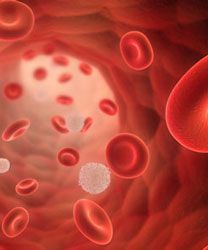Article
Gemtuzumab Ozogamicin Approaches EU Approval for CD33+ AML
Author(s):
The European Medicines Agency’s Committee for Medicinal Products for Human Use has recommended approval of gemtuzumab ozogamicin for use in combination with daunorubicin and cytarabine as a frontline treatment for patients aged 15 years and older with previously untreated, de novo CD33-positive acute myeloid leukemia, except acute promyelocytic leukemia.
mcl

The European Medicines Agency’s Committee for Medicinal Products for Human Use has recommended approval of gemtuzumab ozogamicin (Mylotarg) for use in combination with daunorubicin and cytarabine as a frontline treatment for patients aged 15 years and older with previously untreated, de novo CD33-positive acute myeloid leukemia (AML), except acute promyelocytic leukemia.
The recommendation was based on the phase III ALFA-0701 trial in which the median event-free survival was 17.3 months with the addition of gemtuzumab ozogamicin compared to 9.5 months with daunorubicin and cytarabine alone (HR, 0.56; 95% CI 0.42-0.76; P <.001). The European Commission will now make its final regulatory decision.
“There is an urgent need to improve outcomes for leukemia patients in Europe,” Mace Rothenberg, MD, chief development officer, Oncology, Pfizer Global Product Development, said in a statement. “If approved, the addition of Mylotarg to standard chemotherapy will provide an important new treatment option for patients with acute myeloid leukemia who would typically be treated with chemotherapy alone.
The multicenter, open-label phase III ALFA-0701 trial randomized 271 patients with newly-diagnosed AML to daunorubicin and cytarabine alone (n = 136) or combined with gemtuzumab ozogamicin (n = 135). The median age was 62 (range, 50-70). There were 137 females and 134 males, and 88% had an ECOG performance status of 0 or 1.
CD33 expression on AML blasts by flow cytometry was determined in 72% (n = 194) of the overall patient population. Low CD33 expression (<30% of blasts) was only detected in 14% of patients, and no patients had an expression level of 0.
Patients received induction therapy comprising daunorubicin (60 mg/m2 on days 1-3) and cytarabine (200 mg/m2 on days 1-7) with or without gemtuzumab ozogamicin at 3 mg/m2 (up to maximum of 1 vial) on days 1, 4, and 7. Patient not reaching a response after initial induction were allowed to receive a second induction with only daunorubicin and cytarabine.
Patients achieving a response received consolidation with 2 courses of treatment including daunorubicin (60 mg/m2 on day 1 of consolidation course 1; 60 mg/m2 on days 1 and 2 of consolidation course 2) and cytarabine (1 g/m2 every 12 hours on days 1 -4) with or without gemtuzumab ozogamicin at 3 mg/m2 (maximum, 1 vial) on day 1 according to their initial randomization. Allogeneic transplantation was allowed for patients who achieved remission.
In September 2017, the FDA approved gemtuzumab ozogamicin for adults with newly diagnosed CD33-positive AML, as well as for patients aged 2 years and older with CD33-positive relapsed/refractory AML. In addition to ALFA-0701, the FDA approval was also based on the AML-19 and MyloFrance-1.1 trials.
According to the FDA’s approval statement, common side effects of gemtuzumab ozogamicin include pyrexia, nausea, infection, vomiting, bleeding, thrombocytopenia, stomatitis, constipation, rash, headache, elevated liver function tests, and neutropenia. Severe side effects of the drug include low blood counts, infections, liver damage, hepatic veno-occlusive disease, infusion-related reactions, and hemorrhage.
The US label for gemtuzumab ozogamicin includes a boxed warning for hepatotoxicity, including veno-occlusive disease or sinusoidal obstruction syndrome.
The FDA awarded accelerated approval to gemtuzumab in 2000 for the treatment of patients 60 years or older with CD33-positive AML in first relapse who were not considered candidates for cytotoxic chemotherapy. Wyeth, now Pfizer, voluntarily pulled the drug from the market in 2010 after results from the SWOG-S0106 trial showed that gemtuzumab did not improve rate of complete response, disease-free survival, or overall survival compared with daunorubicin and cytarabine.
Results from subsequent trials suggested that a lower dose—the previous regimen was 2 doses of 9 mg/m2 of gemtuzumab administered 14 days apart—could be combined safely with daunorubicin and cytarabine.
Prescribing information for Mylotarg (gemtuzumab ozogamicin) for injection, for intravenous use. https://www.accessdata.fda.gov/drugsatfda_docs/label/2017/761060lbl.pdf. Accessed February 26, 2018.







%20(2)%201-Recovered-Recovered-Recovered-Recovered-Recovered.jpg?fit=crop&auto=format)
%20(2)%201-Recovered-Recovered-Recovered-Recovered-Recovered.jpg?fit=crop&auto=format)
